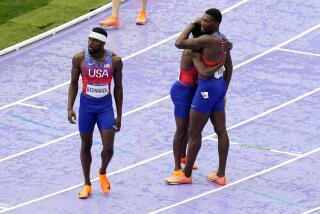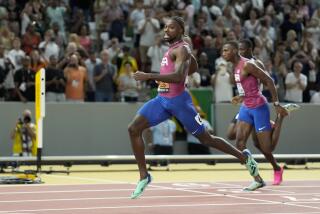‘94 WINTER LILLEHAMMER OLYMPICS : Shimer Is Too Hot, Will Isn’t : Bobsled: One U.S. team is disqualified, the other finishes 15th. Germany II wins the gold.
- Share via
HUNDERFOSSEN, Norway — The Winter Olympics ended prematurely for Brian Shimer when his cold-weather runners came up too hot Sunday.
Shimer was disqualified before the start of the third heat of four-man bobsled when three of the four runners--the steel blades on which the sled rides--failed to meet the required temperature standards.
“I’m in shock,” said Shimer, who isn’t responsible for the sled’s final preparation.
“I mean, I’m not sure I know what happened. I went to the line (as the third starter in the third heat) and the sled wasn’t there. It’s the first time in my nine years I’ve been disqualified over a runners problem.”
If the disqualification of the three-time Olympian seemed to be the ultimate embarrassment for the U.S. Skeleton and Bobsled Federation, traditionally beset by controversy and confusion, there was more on the final day of the Olympics.
Randy Will, driving his own Italian-made sled as USA I, finished behind the Jamaicans of “Cool Runnings” fame.
Will was 15th in his final race and would not talk about it. The Jamaicans, having improved vastly since their much-spoofed debut in the 1988 Olympics, were 14th.
Harald Czudaj, driving Germany II, won the gold, upsetting two-man winner Gustav Weder in Switzerland I by 0.06 seconds, and countryman Wolfgang Hoppe, in Germany I, by 0.23.
In a sport decided by milliseconds, Shimer, 11th after the first two heats, was eliminated by degrees.
“A hot runner reduces friction and makes the sled go faster,” said Matt Roy, executive director of the U.S. bobsled federation.
“That’s why everyone tries to come as close to the limit as possible. We definitely took some risks and pressed the limit. Our engineers felt we were within (the allowable) range, but it’s the staff’s responsibility to make sure. Shimer is preparing to compete. It’s not his job.”
Nor was his hot-runner disqualification an Olympic first.
It has happened in both bobsled and luge. It has happened in World Cups and World Championships.
The perception has long been that the sledders, when heating their runners, stretch the limits whenever and wherever possible.
“It’s not a matter of cheating,” said David Kurtz, assistant U.S coach and team leader.
“Everyone heats runners overnight in electric blankets, but they have to be on the sled 30 minutes before the race and can’t be touched again.”
In an attempt to discourage cheating, the international federation hangs a test runner near the start house. Runners on the competing sleds cannot be more than four degrees warmer than the test runner as the sled comes up to the line.
The test runner was a minus-9.5 degrees, according to U.S. coach Joey Kilburn, and the U.S. sled was disqualified for being 0.3, 0.7 and 0.9 over the minus-5.5 at which the runners could have come in.
“Our guys went ballistic, and I don’t blame them,” Kilburn said. “We did everything by the book. I mean, our gauge showed we were within the limits, and we borrowed the Swiss gauge and it showed we were within the limits. We’re still trying to figure out why there was a discrepancy.”
Said Kurtz: “This happened before the second heat yesterday with one of the Shimer runners, but we asked the jury to check (the temperature of) the test runner again, and it had changed enough to put Shimer’s runner within range.
“We knew we were right on the limit today, but our gauge and the Swiss gauge were running consistent, and they’re the same gauges the jury uses.
“I mean, they’re the same brand but they had different temperatures, and this time we didn’t get a chance to ask for a recheck of the test runner. They pulled the sled so quickly we had no recourse.”
Kurtz shook his head.
“It’s a bitter slice of medicine to digest,” he said. “I think our athletes are of such high caliber that they’ll regroup and refocus and bounce back, but for those of us responsible, myself in particular, it will take some time.”
Shimer was using runners rented from driver Bruce Rosselli because they have been particularly effective in extreme cold. He had been excited about posting the ninth-best time in Saturday’s second heat.
“I’ve heated runners to a point where you can’t touch them, but I don’t see how they stay hot when it’s 10 below,” he said.
“I mean, you never attempt to take a sled to the line with hot runners. If they’re not cooling down properly, you put snow or ice on them. In this case three gauges said we were within the limit, but the one that didn’t was in the hands of the jury.
“It seems like every time we come up with something new (like the Bo-Dyn sled), the U.S. gets the short end.
“It’s as if they have their eye out for us. I’m tired of it.”
Shimer enunciated a long list of international interventions. There are rumors the U.S. Olympic Committee has wearied of a comparably long history of bobsled blundering and plans to force a major shake-up in federation personnel.
As part of it, the bobsled office in Lake Placid, N.Y., might be put under the USOC umbrella in Colorado Springs.
Sunday’s events could prove to be the final blow. They clearly brought a sudden and frustrating conclusion to Shimer’s disappointing season only a year after he had won the World Cup championship, but he is determined to be back in ‘98, at 35, and thinks this will simply “fuel the Bo-Dyn fire that much more.”
“My goal is to come back and dominate the sport,” he said. “This is kind of the icing on the type year I’ve had, and maybe I should have expected it.
“It’s frustrating, but I hope to grow from it. Life goes on. A hundred million Chinese don’t care, and the sun still rises in the East.”
Or as bobsled press liaison Dmitry Feld said, “It was just a technical mistake--of Biblical proportion.”
More to Read
Go beyond the scoreboard
Get the latest on L.A.'s teams in the daily Sports Report newsletter.
You may occasionally receive promotional content from the Los Angeles Times.






